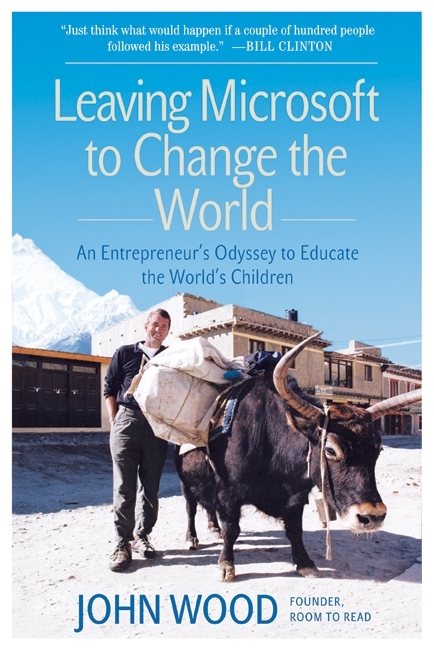Leaving Microsoft to Change the World by John Wood (HarperCollins)
What does a former executive of a multi-national corporation like Microsoft have to do with Asia? Everything! After spending nearly nine years in the fast lane, with almost all of that time heading up the ladder at Microsoft by working long hours and foregoing extended holidays, John Wood thought it was about time to slow down just a little and take an extended break from the rat race. His vacation led him to the mountains of Nepal where there were no phones, no internet service providers, no meetings, no commutes and absolutely no connection to the rest of the business world.
On the first day of his three- week trek in the Himalayas, at a small lodge, an eight- year- old boy offers Wood a drink. Wood asks if they have beer. The boy replies yes, and rushes off to get him a bottle of Tuborg, as if he ran the lodge himself, then apologizes for the beer being warm— but he has an idea! He asks Wood to wait for ten minutes as he takes the bottle to the nearby river and submerges it into the cold water spawned from glaciers.
Wood says to a local man who watched this exchange in amusement, “Who needs a refrigerator?” This quip begins a conversation that will change Wood’s life.
Pasupathi, the man whom Wood meets at the lodge, is the “district resource person for Lamjung Province,” whose job is to find resources for seventeen isolated schools. The children are eager to learn but there is no money to invest in schools or school supplies. Some villages have a primary school which teaches only up to Grade 5; if students want to continue their education, they have to walk two hours to the nearest secondary school. However, families are so poor that children are needed to help with farm work which helps to account for Nepal’s nearly 70% illiteracy rate. Pasupathi says to Wood, “I am the education resource person, yet I have hardly any sources”.
Wood asks to see the school that Pasupathi is on his way to visit and the next day the two men set off on a three-hour trek. At the school Wood is shown a first-grade class with nearly 70 students in a room that can hold barely half that number. He is taken to eight more classrooms all crowded with eager students who stand in greeting and yell “Good morning, sir” in unison, using perfect English. The final room Wood sees has a sign on the door that says SCHOOL LIBRARY. However, the room is empty except for an outdated world map on the wall that still shows countries like the Soviet Union, East Germany, and Yugoslavia. In his most polite manner, Wood says, “This is a beautiful library. Thank you for showing it to me. I have only one question. Where, exactly, are your books?”
The few books the school has are locked in a cabinet so the students won’t damage them. The library features “The Lonely Planet Guide to Mongolia”, “Finnegan’s Wake”, an Umberto Eco novel in the original Italian, and other books forgotten or abandoned by backpackers. Wood asks the headmaster how many students are enrolled in the school and is informed there are 450! The headmaster notices Wood’s surprise and says, “Yes, I can see that you also realize this is a very big problem. We wish to inculcate in our students the habit of reading. But that is impossible when this is all we have. Perhaps, sir, you will one day come with books” And this is where the story begins.
Back in his room after his long trek, the thought of those 450 kids without books will not leave Wood’s mind and he sends an e-mail to all his friends on Hotmail. The message is short and simple. He has found a school that needs books and desks. He will donate the desks. Please send books, he asks—and he gives his parents’ address for his friends to send what they can.
Wood tells his parents to expect the arrival of several hundred books—he soon receives a message from his father that says 3000 books have arrived with more coming every day—come home and help us with this. Wood obeys.
Such is the beginning of “Books for Nepal”. Wood gives up his position at Microsoft and begins to build a nonprofit organization from the ground up, learning how to sell himself and his ideas to gain sponsors and how to run fundraising events. His business background is an asset; “Books for Nepal” is so successful that Wood expands into Vietnam, Cambodia, India, and Laos. He changes the name of his nonprofit as it grows beyond Nepal, and so sprouts “Room to Read.”
Anybody who loves books as much as I do will find this book inspirational and thoroughly absorbing. Those who want to support “Room to Read” can find more information here. by Ernie Hoyt
